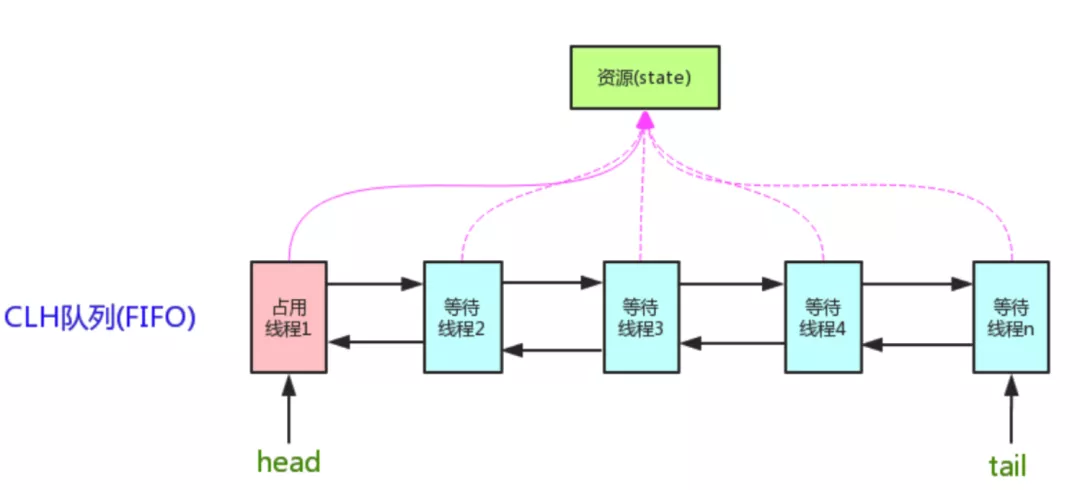深入理解AQS
简介
AQS是Java并发包中很重要的一个抽象类,我们所使用的ReentrantLock、ReentrantReadWriteLock、CountDownLatch、Semaphore等都是基于AQS来实现的。
1.1 实现原理
AQS中维护了一个state变量这个表示共享的资源,以及一个CHL队列(多线程争夺资源的时候被阻塞的线程将会被放进这个队列)。这个队列不需要我们去维护,我们需要关注的几个点就是state变量的获取和释放规则。
state 变量被声明的类型是volatile类型保证多线程下的资源可见性,state=1表示当前资源被占用。
state值的更新是通过CAS操作来保证它修改的安全性。

AQS中提供了以下主要的方法:
- getState():获取锁的标志state值
- setState():设置锁的标志state值
- tryAcquire(int):独占方式获取锁。尝试获取资源,成功则返回true,失败则返回false。
- tryRelease(int):独占方式释放锁。尝试释放资源,成功则返回true,失败则返回false。
这里对应独占锁还有两个方法是对应共享锁的 tryShare方法。
private volatile int state;//共享变量,使用volatile修饰保证线程可见性
//返回同步状态的当前值
protected final int getState() {
return state;
}
// 设置同步状态的值
protected final void setState(int newState) {
state = newState;
}
//原子地(CAS操作)将同步状态值设置为给定值update如果当前同步状态的值等于expect(期望值)
protected final boolean compareAndSetState(int expect, int update) {
return unsafe.compareAndSwapInt(this, stateOffset, expect, update);
}
2.1 一些同步器的实现
ReentrantLock 默认采用非公平锁,因为考虑获得更好的性能,通过 boolean 来决定是否用公平锁(传入 true 用公平锁)。
/** Synchronizer providing all implementation mechanics */
private final Sync sync;
public ReentrantLock() {
// 默认非公平锁
sync = new NonfairSync();
}
public ReentrantLock(boolean fair) {
sync = fair ? new FairSync() : new NonfairSync();
}
ReentrantLock 中公平锁的 lock 方法
static final class FairSync extends Sync {
final void lock() {
acquire(1);
}
// AbstractQueuedSynchronizer.acquire(int arg)
public final void acquire(int arg) {
if (!tryAcquire(arg) &&
acquireQueued(addWaiter(Node.EXCLUSIVE), arg))
selfInterrupt();
}
protected final boolean tryAcquire(int acquires) {
final Thread current = Thread.currentThread();
int c = getState();
if (c == 0) {
// 1. 和非公平锁相比,这里多了一个判断:是否有线程在等待
if (!hasQueuedPredecessors() &&
compareAndSetState(0, acquires)) {
setExclusiveOwnerThread(current);
return true;
}
}
else if (current == getExclusiveOwnerThread()) {
int nextc = c + acquires;
if (nextc < 0)
throw new Error("Maximum lock count exceeded");
setState(nextc);
return true;
}
return false;
}
}
非公平锁的 lock 方法:
static final class NonfairSync extends Sync {
final void lock() {
// 2. 和公平锁相比,这里会直接先进行一次CAS,成功就返回了
if (compareAndSetState(0, 1))
setExclusiveOwnerThread(Thread.currentThread());
else
acquire(1);
}
// AbstractQueuedSynchronizer.acquire(int arg)
public final void acquire(int arg) {
if (!tryAcquire(arg) &&
acquireQueued(addWaiter(Node.EXCLUSIVE), arg))
selfInterrupt();
}
protected final boolean tryAcquire(int acquires) {
return nonfairTryAcquire(acquires);
}
}
/**
* Performs non-fair tryLock. tryAcquire is implemented in
* subclasses, but both need nonfair try for trylock method.
*/
final boolean nonfairTryAcquire(int acquires) {
final Thread current = Thread.currentThread();
int c = getState();
if (c == 0) {
// 这里没有对阻塞队列进行判断
if (compareAndSetState(0, acquires)) {
setExclusiveOwnerThread(current);
return true;
}
}
else if (current == getExclusiveOwnerThread()) {
int nextc = c + acquires;
if (nextc < 0) // overflow
throw new Error("Maximum lock count exceeded");
setState(nextc);
return true;
}
return false;
}
总结:公平锁和非公平锁只有两处不同:
非公平锁在调用 lock 后,首先就会调用 CAS 进行一次抢锁,如果这个时候恰巧锁没有被占用,那么直接就获取到锁返回了。
非公平锁在 CAS 失败后,和公平锁一样都会进入到 tryAcquire 方法,在 tryAcquire 方法中,如果发现锁这个时候被释放了(state == 0),非公平锁会直接 CAS 抢锁,但是公平锁会判断等待队列是否有线程处于等待状态,如果有则不去抢锁,乖乖排到后面。
公平锁和非公平锁就这两点区别,如果这两次 CAS 都不成功,那么后面非公平锁和公平锁是一样的,都要进入到阻塞队列等待唤醒。
相对来说,非公平锁会有更好的性能,因为它的吞吐量比较大。当然,非公平锁让获取锁的时间变得更加不确定,可能会导致在阻塞队列中的线程长期处于饥饿状态。


